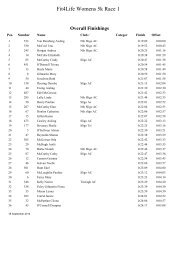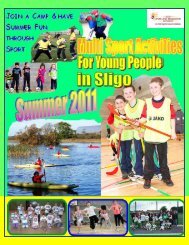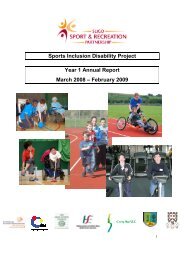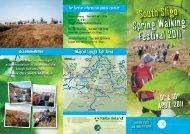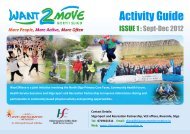Girls Active Programme - Sligo Sport and Recreation Partnership
Girls Active Programme - Sligo Sport and Recreation Partnership
Girls Active Programme - Sligo Sport and Recreation Partnership
Create successful ePaper yourself
Turn your PDF publications into a flip-book with our unique Google optimized e-Paper software.
Aims <strong>and</strong><br />
Methodology of<br />
the Evaluation<br />
3.1 Aims<br />
<strong>Girls</strong> <strong>Active</strong> is the first programme of its kind in the<br />
country <strong>and</strong> provides a possible template for further<br />
roll-out on a national basis. At the end of its second<br />
year in operation, therefore, it was considered<br />
timely to review the implementation, achievements,<br />
lessons, sustainability <strong>and</strong> future potential of the<br />
<strong>Girls</strong> <strong>Active</strong> programme.<br />
The evaluative study utilises various criteria for<br />
reviewing the operation of <strong>Girls</strong> <strong>Active</strong> together with<br />
the impacts <strong>and</strong> challenges that have arisen during<br />
the course of its implementation, as follows:<br />
An examination of the achievements of the<br />
programme set against its originally stated aims<br />
<strong>and</strong> objectives. Key indicators for measuring the<br />
actual outcomes of the programme are:<br />
• Numbers of schools <strong>and</strong> girls participating in<br />
the programme over successive years.<br />
• Levels of awareness of the benefits of physical<br />
activity among the participating girls.<br />
• Levels of physical activity undertaken by the<br />
girls subsequent to involvement in <strong>Girls</strong> <strong>Active</strong>.<br />
• Extent of recognition within schools for nontraditional<br />
recreational sporting activities.<br />
• Attitudes to, <strong>and</strong> experiences of, the programme<br />
by all stakeholders, including its challenges <strong>and</strong><br />
lessons.<br />
An assessment of inputs into the programme <strong>and</strong> of<br />
its implementation on the ground can be achieved by<br />
analysing its structures <strong>and</strong> by obtaining feedback<br />
from all stakeholders.<br />
3.2 Methodology<br />
A variety of methods has been employed to gather<br />
data for the present review, primarily including a<br />
questionnaire survey of participating girls <strong>and</strong> case<br />
studies of three participating schools.<br />
3.2.1 Questionnaire Survey<br />
For simplicity <strong>and</strong> coherence, the survey targeted<br />
those girls still at school who participated during<br />
Phase Two, 2004/5 14 . It was designed to explore the<br />
experience of participating girls – their expectations<br />
of the programme, their experience of it in terms of<br />
its implementation in their school <strong>and</strong> their attitudes<br />
to how it might have impacted on them personally.<br />
The questionnaire consisted of 18 questions <strong>and</strong><br />
took approximately 20 minutes to complete (the<br />
full questionnaire is reproduced in Appendix B). To<br />
a large extent the questions were pre-coded <strong>and</strong><br />
asked the informant to choose one or more from a<br />
set of pre-selected answers. <strong>Girls</strong> <strong>Active</strong> support<br />
personnel administered the questionnaire to all the<br />
girls still in school who had participated in 2004/5<br />
(apart from one school who were unavailable at the<br />
time of the survey).<br />
Basic quantitative analyses were carried out on the<br />
resulting data using the SPSS statistical package<br />
to produce descriptive statistics, appropriate<br />
measures of central tendency <strong>and</strong> some statistical<br />
tests of significance such as the Wilcoxon Signed<br />
Ranks Test designed to compare the distributions<br />
of two different variables.<br />
3.2.2 Case Studies<br />
Three schools were selected as case studies for<br />
more in depth investigation of the programme from<br />
the perspective of the participating school. They<br />
were undertaken following a preliminary analysis<br />
of the findings from the questionnaires in order to<br />
generate qualitative <strong>and</strong> explanatory data on the<br />
themes emerging from the questionnaire survey.<br />
The selected schools were chosen on the basis<br />
that they agreed to be involved, were located in<br />
each of the three counties <strong>and</strong> represented a<br />
cross-section of participating schools in terms of<br />
size, length of involvement <strong>and</strong> relative success<br />
with the programme.<br />
Focus groups <strong>and</strong> interviews were the main datagathering<br />
tools employed. With parental approval,<br />
a group of 10-12 girls who had participated on<br />
<strong>Girls</strong> <strong>Active</strong> during Phase Two were presented<br />
with a series of questions by the researcher in<br />
Evaluation of the <strong>Girls</strong> <strong>Active</strong> <strong>Programme</strong> - 2003 – 2005 Report 9



